6 months ago and one day I gave birth to our daughter. I was reminded today of an email that I wrote in the weeks shortly after her birth.
Continue reading “Some time passed. And then a birth.”Permaculture Speed Dating / Urban Permaculture Discussion Questions
I wanted to share a series of discussion questions broadly related to urban permaculture and having a cooler city in the summer.
I’ve been fortunate enough to visit Kosovo three times over the last year or so, twice for permaculture teaching with GAIA Kosovo and once for fun and planning. On the most recent trip I hosted an Introduction to Permaculture for GAIA Kosovo’s volunteers, visited Mitrovice and gave a presentation there and led a short workshop on the permaculture principles and urban permaculture at Termokiss in Pristina.

Broadening The Discussion
I always emphasise that while permaculture has a food production focus, it is ultimately about actively caring for both people and planet from a systems thinking perspective and that can be performed through more than just growing food. Urban permaculture activities have a very different context than those in rural or suburban areas. Often there are significant issues regarding pollution as well as social and structural problems that need to be responded to, often as a parallel problem to establishing food production projects. I feel a great responsibility to present permaculture as an entry point into many different activities – not everyone wants to grow food, but everyone can be empowered to care for people and planet.
Patterns and Details
Preparing for this workshop I was reminded about the importance of patterns and details and how that can help us understand challenges and respond to them. While I started writing questions about Pristina, I knew that the same discussions would be just as relevant in Linz, or Adelaide. Pristina, Kosovo is one of the most polluted cities on the European continent, water security is an issue, corruption is still a major problem, there are significant issues around equality between different religious and minority groups and the post-conflict status of Kosovo as a nation is unclear. While Pristina has its own particular history and combination of present day problems, it is important to acknowledge that issues of pollution, water and food security, inequality, corruption and conflict histories are present everywhere in the world. For example littering and air pollution were previously significant problems in Australia until social norms and regulations changed, yet its frontier wars and history of Indigenous genocide and social inequality are mostly unacknowledged. It is easy to look at the problems or solutions of other places and presume that one society has everything fixed or another one failing. There is always something to improve and ways to learn from other people, just as there is always progress and ideas to be shared.
Customising a Workshop Design
We weren’t sure how many people would attend the Termokiss workshop and had there been a bigger group I’d have invited them to participate in a “Permaculture Speed Dating” exercise. In this format I would have given a very short introduction to permaculture and then divided the group by birth month. Then for example I would have asked all the people in January to choose an urban permaculture question related to “Observe and Interact” and to then discuss it with one or more other people. After 5 minutes they would then swap onto the next principle, so that by the end of an hour everyone would have worked through all of Holmgren’s design principles.
The group of participants I was presenting to was small and pretty fluid as some people had to leave and more people arrived. This meant that I ran a longer discussion based introduction to the principles and ethics. Following the presentation side of things I invited the participants to select a question from the list below and to discuss it in small groups. Once we regathered I asked participants to think of two actions they would do to practice the permaculture ethics, one for the next week and one through the summer. This final reflection was a very empowering experience as for example, one person said they would try to grow a plant for the first time in their life, another wanted to try making seed bombs and some of the people from Termokiss were going to start a seed library.
In many ways it was lucky that we had a smaller group as I think the questions would need to be refined to suit a limited time frame. Alternatively they could be reworked to host 4 or 5 stations of speed dating but still with urban permaculture related questions.
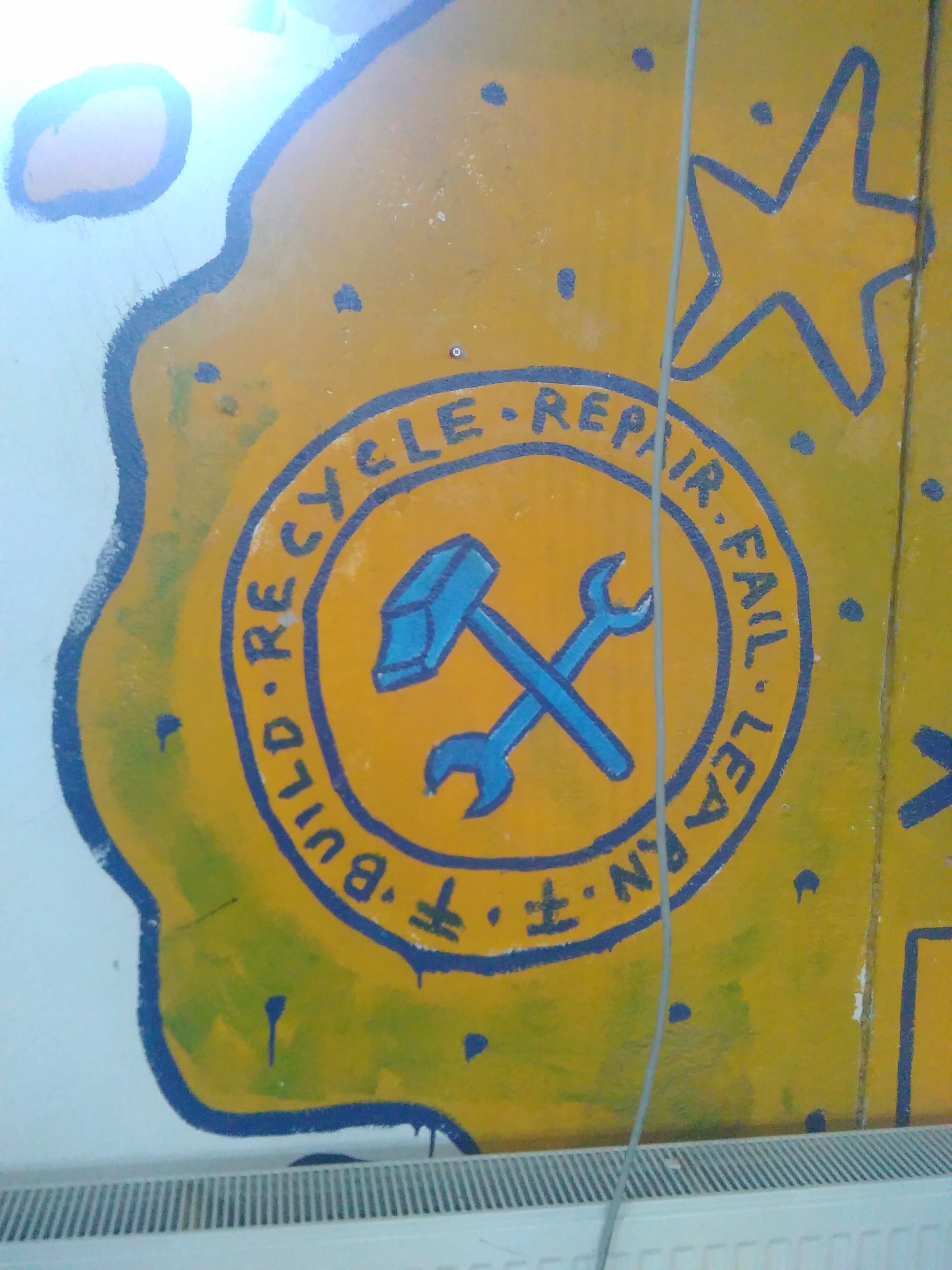

The Questions
OBSERVE AND INTERACT
- In the Summer, what places in your home and the city feel cooler than others? Why?
- Do you know if the soil near your home is healthy or not? Even if growing food or medicine for humans is not a good idea you can still grow a garden that provides beauty, shade, good smells as well as homes and food for wild animals and insects.
- Do you know the names of your neighbours? Do you think any of them might need extra help during very hot weather?
CATCH and STORE ENERGY
- You can use solar and wind power without expensive technology. How can you catch or block the sun and wind to make your home or workplace more comfortable this summer?
- Have you ever tried saving seeds from trees or food plants? Do your grandparents save seeds? Have you ever swapped seeds? Seed saving supports biodiversity, can save you money and helps maintain traditional / heirloom plant varieties.
OBTAIN A YIELD
- What changes could you make to your home or community that will have benefits this summer and in the future?
- What benefits do you get from nature? Beauty, clean air, water, food, places to play, sunshine? What can you do to help nature provide these resources and services?
APPLY SELF-REGULATION AND ACCEPT FEEDBACK
- Have you ever calculated your ecological footprint? Do you know how much water and energy you use each year?
- Do you feel better when you are in nature filled places? How can you plan your week to spend more time in nature?
- How often do you buy drinks in plastic bottles? Can you reuse a bottle and drink more water this summer?
USE AND VALUE RENEWABLE RESOURCES AND SERVICES
- Are there vacant pieces of land, or cracks in the pavement where you could plant a garden? Trees and garden areas help keep the city cool as well as providing many other benefits such as beauty, controlling storm water and food and homes for wildlife.
- Can you use the wind to cool your home? In hot weather it is often better to keep your windows closed and shaded during the heat of the day and to open them up in the cool of the evening.
- How do you look after the precious water you use in your home? Choosing the most eco friendly detergents and soaps you can find and avoiding throwing chemicals away in drains can help keep Kosovo’s waterways clearer.
PRODUCE NO WASTE
- Often we need to use polluting energy to power appliances or drive somewhere. What can you do to get the most out of that energy use? (eg. car pooling, cool just one room of the house, keep refrigerators in cool places)
- The best way to keep plastic bags out of the environment is to not use them in the first place. Have you ever tried refusing a plastic bag when shopping? What was the reaction from the shopkeeper?
- What do you reuse or repurpose? Old bubble wrap packaging can be used to insulate windows from the summer sun and winter cold. Socks and scrap fabric can be sewn to make “snakes” that block draughts in cold weather.
- How do you save water in the home? If eco-friendly soaps are used, “Grey Water” from your shower or bath, and from clothes washing can be used to water gardens and houseplants. Alternatively this waste water can be used to flush the toilet.
- What happens to your food scraps? Can they be composted and used to feed the soil in a garden? Food waste which goes into normal trash attracts pests and releases methane, a greenhouse gas. Using waste food and other biological waste to make compost means that plants can be fertilised without chemicals. Paper and cardboard scraps can also be mixed with the food waste.
DESIGN FROM PATTERNS TO DETAILS
- Think of your favourite natural place. Maybe it is a forest, a park or a garden. What patterns and ideas can we take from nature to inspire a beautiful, cool and clean Pristina and Kosovo?
- Imagine the place where you live and how it feels at different times of the day or the year. How does the movement of the sun and wind affect how warm or cool your home is. Do you use your home differently between summer and winter?
- Environmental problems in Pristina are very similar to problems in the rest of the world. Do you know of how other groups have responded to build community gardens, clean up water ways in their local area? What ideas can you copy from other places and what challenges are unique to Kosovo?
INTEGRATE RATHER THAN SEGREGATE
- It is possible to do things alone, but much more effective and fun when we work together. Can you think of a neighbour, family member or organisation you could team up with to make positive changes in your local community and natural environment this summer?
- Can you think of ways to connect parks, gardens and the outer areas of Pristina? In order to support a healthy population birds, animals and insects need pathways to travel along. Where would you put nature pathways in Pristina?
USE SMALL AND SLOW SOLUTIONS
- Have you heard about seed bombs? They are balls made of clay, soil and local wildflower and tree seeds which will begin to grow after a rainstorm. Throwing seed bombs into abandoned land can help nature beautify ugly parts of the city. Where would you throw a seed bomb?
- Can you think of places where you could plant a tree or other plants for the future? If the best time to plant a tree was twenty years ago, the second best time is this year. Trees take a long time to grow and need the company of friendly plants in order to be healthy.
USE AND VALUE DIVERSITY
- What are your skills? What do you want to learn? Can you work with friends to start a learning exchange?
- Can you name five or more plants that grow in the city?
- What can you do to help the elderly, the very young, those with disabilities or ethnic minority groups? Air and water pollution, extreme heat and cold will have bigger impacts on certain groups in society who are already struggling and vulnerable.
USE EDGES AND VALUE THE MARGINAL
- Are there tiny corners of the city where you could grow a garden? Guerilla gardening and moss graffiti are ways to temporarily beautify your neighbourhood and provide benefits for wildlife.
- Edges of ecosystems eg. alongside rivers, are places of richness and diversity – materials gather and there are specific microclimates. Around the world (not just in Kosovo) roadsides seem to magically gather trash. Can you choose a street to care for?
- In high summer walls and roofs exposed to the sun will heat up and make a building more uncomfortable. Is it possible to use climbing plants to shade the place where you live?
CREATIVELY USE AND RESPOND TO CHANGE
- What was summer like when you were a child? How has the weather changed over recent years?
- What do you want your life to be like in the year 2031? Will you have a family of your own? Will you live in Pristina or somewhere else? How will climate change affect your dreams? What can you do now to make Pristina cleaner and cooler and at the same time mitigate global climate change?
Principled “Horoscopes”
My partner’s arts collective Time’s Up develop physical narratives of future scenarios. Or to put it another way, that means they imagine a possible future based on current trends and build and decorate a set that illustrates that story world. Visitors to the space are invited to walk through the exhibition and explore the spaces and details (rooms, audio landscapes, furniture, posters) of a particular imagined future in the fictional harbourside town of Turnton in the year 2047. Over the past fortnight Time’s Up have been installing the most recent incarnation of the Turnton world into the Angewandte Innovation Lab in Vienna, Austria.
One major artefact that Time’s Up develop to explain the ecologically damaged but socially improved world of September 2047 is a newspaper. While it might seem odd that “old-fashioned” technology such as newspapers exist in the future, it is suggested that as the concept of newspapers has endured many centuries so far, it is likely they’ll still exist in 28 years.
Making a newspaper means filling the newspaper out with articles, advertisements and things like comic strips and crosswords. While the core members of Time’s Up write many of the stories, they also invite their broader community of collaborators to contribute material.
Newspapers often include horoscopes and Tim suggested that I contribute that content. While I am quite interested in planetary alignments and transits and their implications for how to plan gardening and personal activities I am not an astrologer! Instead we decided to use Holmgren’s 12 principles and use them as the basis for each sign’s text.
I tried to make the texts somewhat instructional about social permaculture and to provide permaculture ideas by stealth. I do hope that in the year 2047 our world is far more ethical and ecologically minded than it currently is.
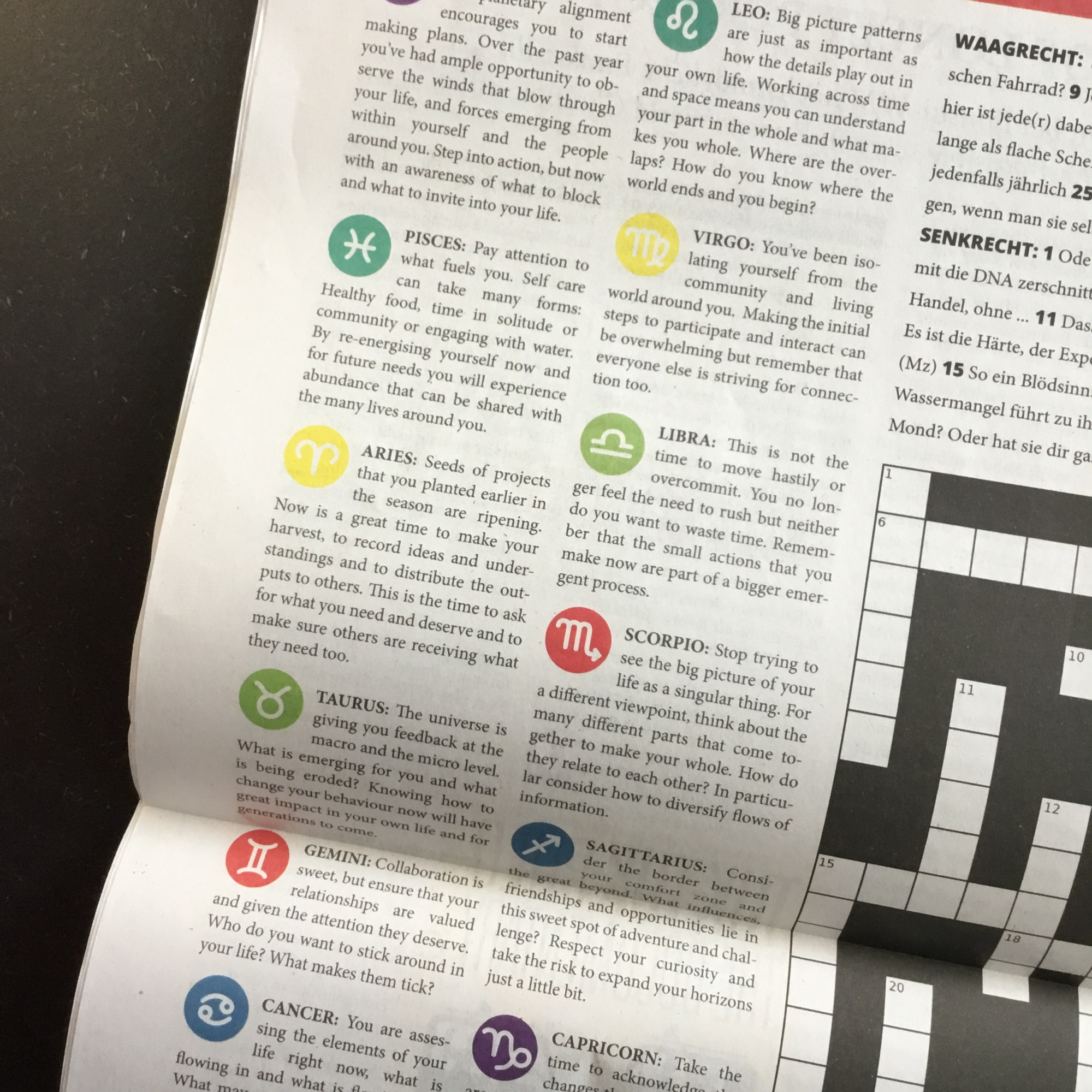


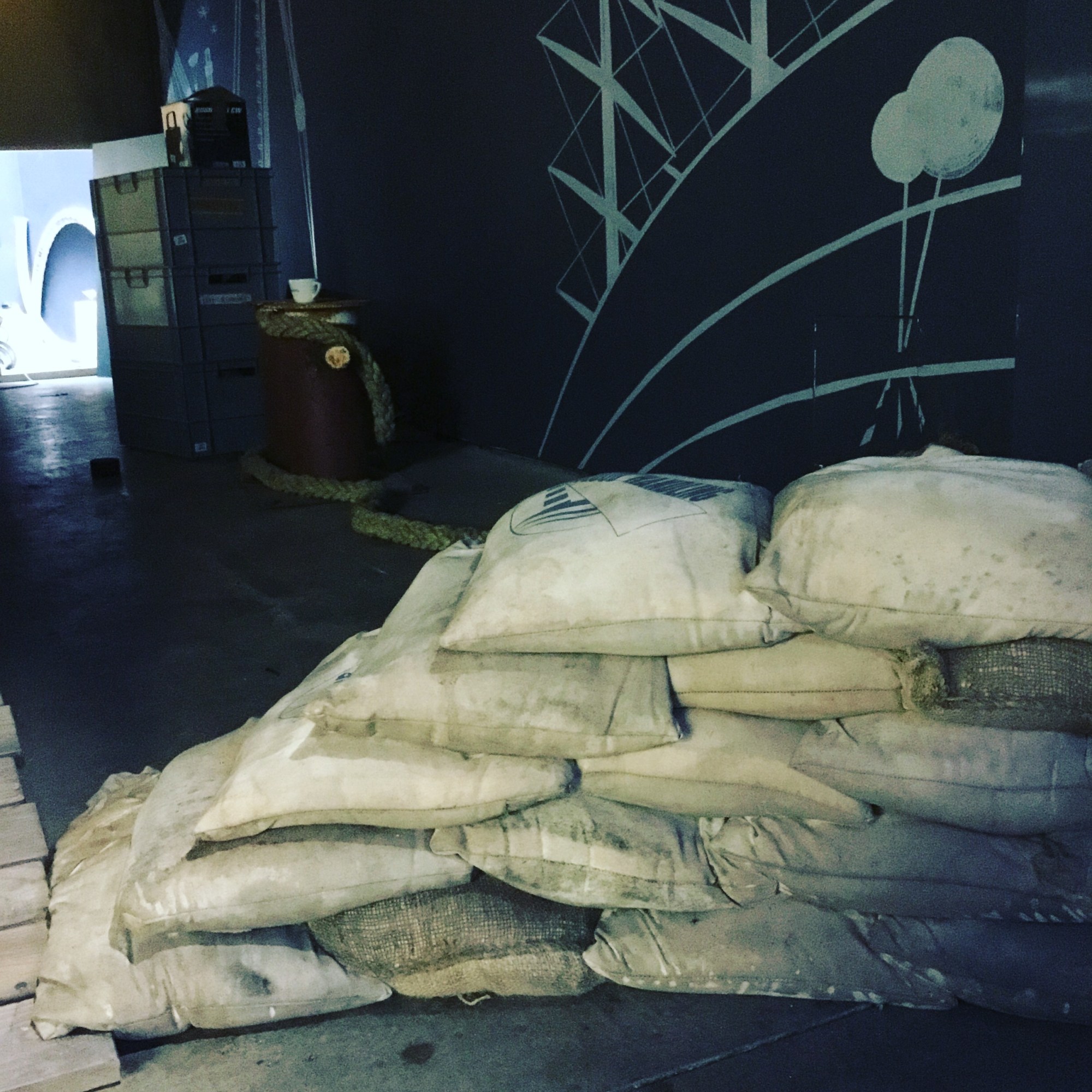
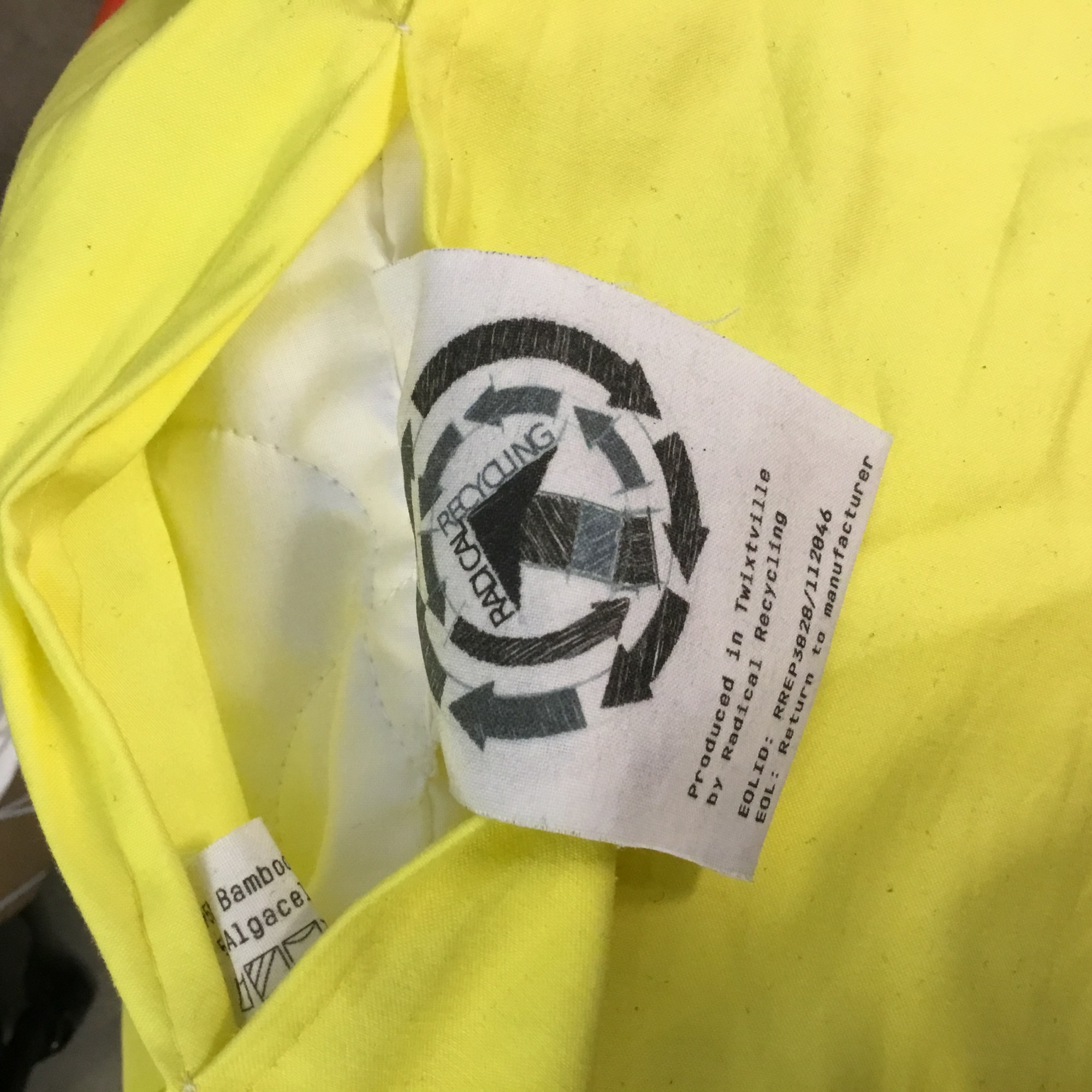

I also helped out with the setup of the exhibition (filling holes and ageing sandbags) and made details like care labels from the future for some of the textile based elements.
Offering to contribute to the exhibition follows on from one of the outcomes of my plant woman design which was to get involved in more collaborative art making.
One of the reflections that we had was that maybe in the year 2047 there are no horoscopes in newspapers but just permaculture advice? I actually like the idea of both the astral bodies and permaculture getting the recognition they deserve. Regardless, if you’d like to find out your sun sign’s permaculture advice for Friday 13th September 2047 please read below.
Aquarius / Observe and Interact this week the planetary alignment encourages you to start making plans. Over the past year you’ve had ample opportunity to observe the winds that blow through your life, and forces emerging from within yourself and the people around you. Step into action, but now with an awareness of what to block and what to invite into your life.
Pisces / Catch and Store Energy Pay attention to what fuels you. Self care can take many forms: healthy food, time in solitude or community, engaging with water or natural systems. By reenergising yourself now and for future needs you will experience abundance that can be shared with the many lives around you.
Aries / Obtain a Yield Seeds of projects that you planted earlier in the season are ripening. Now is a great time to make your harvest, to record ideas and understandings and to distribute the outputs to others. This is the time to ask for what you need and deserve and to make sure others are receiving what they need too.
Taurus / Apply Self-Regulation and Accept Feedback The universe is giving you feedback at the macro and the micro level. What is emerging for you and what is being eroded? knowing how to change your behaviour now will have great impact in your own life and for generations to come.
Gemini / Use and Value Renewable Resources and Services Collaboration is sweet, but ensure that your relationships are valued and given the attention they deserve. Who do you want to stick around in your life? What makes them tick?
Cancer / Produce No Waste You are assessing the elements of your life right now, what is flowing in and what is flowing out.. What may seem worn out and stale may still serve another purpose even if you aren’t the one who will see it.
Leo / Design from Patterns to Details Big picture patterns are just as important as how the details play out in your own life. Working across time and space means you can understand your part in the whole and what makes you whole. Where are the overlaps? how do you know where the world ends and you begin?
Virgo / Integrate Rather Than Segregate You’ve been isolating yourself from the community and living world around you. Making the initial steps to participate and interact can be overwhelming but remember that everyone else is striving for connection too.
Libra / Use Small and Slow Solutions This is not the time to move hastily or overcommit. You no longer feel the need to rush but neither do you want to waste time. Remember that the small actions that you make now are part of a bigger emergent process.
Scorpio / Use and Value Diversity Stop trying to see the big picture of your life as a singular thing. For a different viewpoint, think about the many different parts that come together to make your whole. How do they relate to each other? In particular consider how to diversify flows of information.
Sagittarius / Use Edges and Value the Marginal Consider the border between your comfort zone and the great beyond. What influences, friendships and opportunities lie in this sweet spot of adventure and challenge? Respect your curiosity and take the risk to expand your horizons just a little bit.
Capricorn / Creatively Use and Respond to Change Take the time to acknowledge the changes that are unfolding around you at small and large scales. How can you best respond in order to take advantage of the changing tides? Look around and see who you need to collaborate with at this moment in history.
Time’s Up’s exhibition Change Was Our Only Chance is at AILab as part of the Vienna Biennale until September 27, 2019.
Permaculture Diploma: OK, now it’s official
Back in May I worked on my Holistic Context and mentioned that I was about to officially sign up to make the Applied Diploma in Permaculture Design. And then I didn’t. Honestly, you can sometimes really want to do something, but the conditions aren’t fitting. Over the last months things have fallen into place, I decided to go with my first choice of tutor, and yesterday I finally made the formal administrative payment to Permaculture Association UK.
Primarily, I wasn’t 100% sure whether completing a diploma under the UK system was the right choice – I live in Austria which has its own diploma system and intend to move back to Australia. Interestingly, Australia currently has no national association led diploma, instead a TAFE competency-based diploma and several private institutes offering diploma accreditation 1. I did think long and hard about completing a diploma under the Austrian system, especially as documenting and communicating in German would have been a useful learning process. Generally though completing a diploma in German would have been counterproductive as in the longer term my primary teaching language will always be English.
So it was back again to deciding between the Australian approaches and that which is offered by the Permaculture UK. Australia’s TAFE diploma of permaculture is heavily focused on specific competencies rather than broader systems awareness and the social, educational, holistic and organisational topics which I know will make up a good half of my designs. Working with a private institution like Rowe Morrow’s Blue Mountain’s Permaculture Institute would also be possible, but be relatively unstructured.
All of this thought has been worth it though. I’m lucky enough to be in semi-regular contact with Rosemary Morrow so know that she’ll be an ongoing influence on my work. Additionally I’m going to draw on the TAFE competencies as inspiration and reference points to document my applied diploma with. This should give me the opportunity to get my applied diploma part-recognised within the Australian system and open up the pathway to teach under the TAFE accredited system too.
In the end I returned to the UK offering which is well documented, in ongoing review and with a very clear permaculture design process supporting the diploma system itself. I’m also really excited to be working in a system that is working to explore a broad range of permaculture such as KT Shepherd’s Designing Dying or Cathrine Løvetand’s Universal Tea designs.
Diploma Core: Setting a Holistic Context
Previous learning pathway: #diymasters
About a decade ago when I first moved to Berlin I realised that I probably should have found a Masters degree to study rather than flippantly moving across the world without a plan. Instead I not only blogged but tweeted about the idea of somehow doing a DIY Masters degree. People followed and cheered me on, I had a #diymasters hashtag and to this day I still have people from those years ask “what happened to the DIY Masters?”
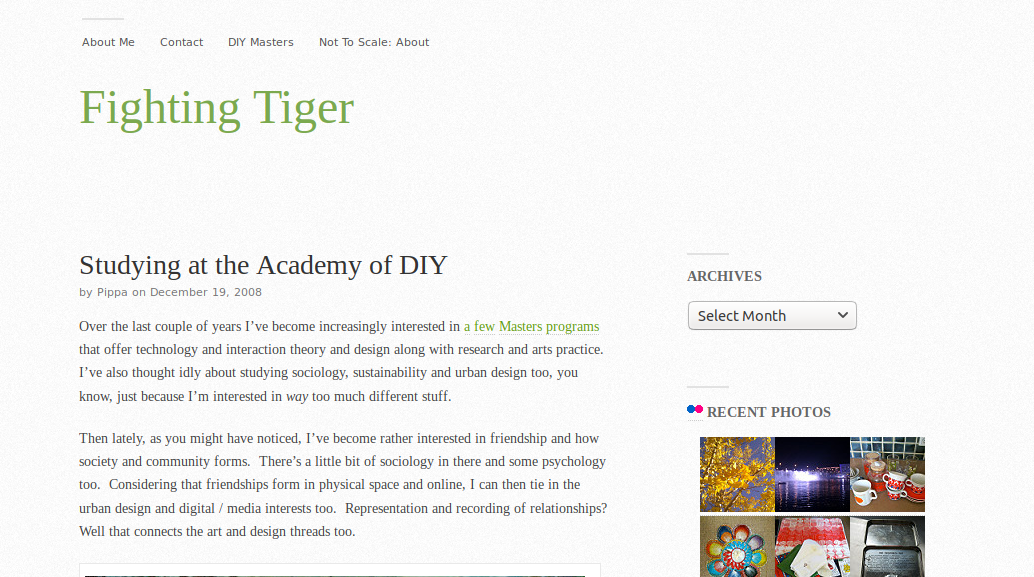
While I did learn a lot and completed a Graduate Certificate in Adult Teaching and Learning, I never did “finish my DIY degree”. Instead the experience brought me a degree of online notoriety, new friends, a couple of pretty awesome jobs, I was interviewed for books and spoke at festivals, met my future husband and developed a deeper understanding of the challenges and benefits of studying outside of “the system”.
Through this process I learned that I loved learning and education and the ways in which formal and informal modes could be blended in meaningful and accessible ways. I was discovering that learning how to remake a sweater found on the street or how to host a conversation online was just as important for me as learning about the academic research that supported good modes of assessment.
Representing that learning in a way that was meaningful was difficult. Initially I’d latched onto the idea of framing my studies within media art (it was Berlin in 2008). At the same time I was realising that work focused on technology was not my cup of tea. The jobs I’d been so lucky to end up in as a result of my project took over much of the time I had available to study. I was living in a new town and had no local support system. I wanted to learn everything it seemed, so had no core theme of study, lacked a set of peers or mentors working on similar topics, and was working blind without any example of what a DIY Masters would look like, let alone a core philosophical or methodological approach.
Previous learning pathway: MSc SA at Center for Alternative Technology
A few years ago, just a couple of weeks after I participated in my first permaculture design course (PDC), I finally started an actual Masters degree which was in many ways fantastic. Not only was I passionate about the topics of sustainability and climate change adaptation, I was also learning alongside a crew of like minded people and making visits to one of the most unusual and beautiful campus I know of.
At the same time I was stuck in a Science context with a particular set of expectations on how knowledge should be taught, learnt and represented. Our topics of study included discussions of how climate adaptation could totally transform society for the better. Yet while we were learning in a rammed earth building and had some really exciting practical learning, for the most part we were still sitting in rows looking at Powerpoint in order to write 2000 word essays that replicated the modes of an existing system. For me, it was all a little frustrating. Still, I made my way through the degree, redesigned one of their modules to include participatory futuring exercises and stressfully wrote and passed a masters thesis.
Again though, I learnt a lot even though in retrospect I’d do things differently. Such is life.
Current Learning Pathway: Applied Permaculture Diploma
Which brings me up to now, May 2018. I’m about to formally sign up for my Applied Permaculture Diploma within the British system. It feels like I am finally setting out to do an actual #diymasters project, but this time in the far more supportive arms of permaculture. Permaculture diplomas are a roughly structured, but self-organised learning journey which demonstrate how an individual is using permaculture design and practice in their life and work.
Technically the diploma process can begin immediately after one has completed a PDC, but in my case a related masters degree got in the way. Having reread through the diploma guidelines for about the 6th time it feels like the positive and negative experiences of the studying a formal masters can only make my diploma experience better.
As a preliminary exercise for my Learning Design (AKA Action Learning Plan, Design Learning Plan) I’ve started thinking in more details about my goals for the Diploma. As part of this I’ve written the first draft of a personal Holistic Context. This is a tool that comes from Holistic Management, the land, farm and life management system developed by Allan Savory. Preparing a Holistic Context includes identifying the whole being managed (a farm, organisation or in this case, an individual) , the decision makers, stakeholders and the supporting social, ecological, physical and economic resource bases. Once the whole is defined you then describe the desired quality of life you are working to achieve and the optimum state you want your resource bases to reach with your assistance and management.

Using Holistic Mangement techniques for goal setting, project framing and decision making is increasingly being recommended as a core stage of regenerative and permaculture design by people I respect like Byron Joel, Milkwood Permaculture, Dan Palmer and Darren Doherty. My partner and I use this as a way of framing our relationship and I am also using Holistic Management in my work with Fair Harvest Permaculture, an organisational design that will also be part of my diploma.
Sector analysis: identifying risks and designing solutions
I love so many aspects of permaculture: the delicious food produced by permaculture gardeners, the sense of global and local community it fosters, the sustainable changes it has supported me to make in my life and the beauty in the nature it helps me see. At a more pragmatic level I also know that permaculture gives individuals, households and communities the tools, attitudes and skills we need to design abundant, inclusive and resilient futures.
This mix of sustainability and resilience is one of the delightfully simple, yet complex aspects of permaculture. A well-designed and managed permaculture system will be resource efficient, productive and may well sequester greenhouse gases, but it will also be a resilient system better able to deal with the inevitable effects of climate change such as natural disasters like floods or wildfire.
The potential for disasters happen when systems can not handle extremes or cumulative stress. One week of limited spending may be a challenge, but a medical bill on top of long-term debt and structural poverty may force a family into homelessness. Water is essential for life, but the extremes of either drought or flood-causing torrential rain can cause havoc in both natural and human systems.
Designing land, the built environment, lifestyles, livelihoods and organisations to deal with extremes as well as everyday conditions is essential for resilience. Resilience is the ability of a system to handle change. There are many ways in which permaculture design and practice supports resilience. In order for designers to design for resilience, they first need to understand what extremes are most likely to have an impact on a site. This is why careful observation and sector analysis is so important for a successful project.
In this video from the Permaculture Women’s Guild Permaculture Design Course I get really excited about sector analysis and visualised data like wind roses. Then again, I am really excited about permaculture and regenerative design in general.
Sector analysis is a critical tool for visually representing observations about identifying how a site may be affected by the “sectors” or the external forces and elements that move through or otherwise influence a project. The sectors recorded can be related to effects on the site caused by climate, ecology, geology, topography and society. For example sun paths, wind and rain patterns, invasive plants, wildlife, pollution, neighbours, areas of high fire threat, views and noise could all be recorded on a sector analysis map.
Sectors are often represented as labelled wedges, arcs or arrows representing the origin and direction of the element. However, rocky areas, contaminated soil, boggy land, or areas of flood risk are better represented as location specific patches over a base map. Some uncontrollable issues such as geological instability or limiting factors such as legal restrictions are harder to represent visually and are best recorded in writing.

In the Permaculture Women’s Guild Permaculture Design Course (PWGPDC) my colleague Jennifer English Morgan introduced the idea of Designer’s Mind. One aspect of developing Designer’s Mind is about making observations free of bias. The forces recorded on a sector analysis are neutral and can be both beneficial or harmful. For example knowing that dry summer winds come from the east of a site helps identify the best place to locate a laundry line or to hang produce for drying. At the same time that drying wind will quickly evaporate water from soil as well as dams or ponds. This information guides the placement of windbreak plantings or hedges on the eastern side to moderate the impact of the wind and reduce evaporation.
Used together with permaculture design tools such as zone analysis, sector analysis helps guide the placement of components so that they make best use of, or mitigate the risks of that sector. Sector analysis influences which zones are placed where, but at the same time, zones influence the strategies used to respond to external forces. In outer zones such as 3 or 4, lower cost, less energy demanding solutions such as windbreak plantings are used to slow the wind. Closer to the home more intensive solutions such as walls or use of gray water might be used to protect water-demanding plants, animals and people from a drying wind.

Permaculture designers make a sector analysis for every design project whether it is a farm, balcony garden or community project. Within larger designs, major subsystems such as high intensity vegetable beds may also benefit from their own sector analysis that includes smaller scale micro-climate influences like the impact of trees casting shade.
Working on sector analysis is a great way to review and incorporate the ideas from Permaculture Design Course modules on climate, ecology, water, earthworks, soil and passive solar building design. Knowing how and why to make a sector analysis is a first step in designing mitigation approaches for the major extremes whether they be fire, flood, drought or legal challenges.
You can learn more about sector analysis and other aspects of permaculture design and practice in the Permaculture Women’s Guild Permaculture Design Course (PWGPDC). Along with my colleagues we’ve put together an online learning experience which includes advanced modules on social and emotional permaculture as well as core land-based permaculture content.
In the PWGPDC I present an in-depth module on Designing for Resilience: Chaos and Catastrophe. I consider the social and structural conditions that make people more vulnerable to disaster as well as the design approaches we can use to make our sites safer. My final Masters project explored how natural hazards are dealt with by permaculture designers and teachers and my results showed that “designing for catastrophe” is currently focused on the physical aspects of disasters rather than the people care aspects that increase coping capacity.
Lest we forget everything
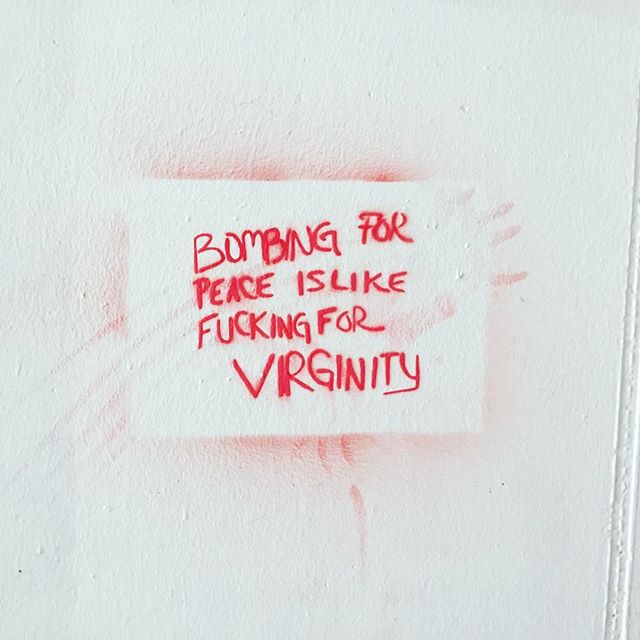
Lest we forget that wars and violence are still happening, that civilians are affected too, that the combatants who come home are often invisibly damaged, that our governments fail to ethically and successfully care for those who flee. Lest we forget those who drowned on the way to Gallipoli or seeking refuge from conflict, lest we forget the non-human victims of violence, lest we forget the genocidal wars of colonisation and the Indigenous people who died protecting country. Lest we forget (Manus, Nauru, Syria, Palestine). Lest we forget that there are people who profit from war and that peace is a much harder struggle.
At the going down of the sun and in the morning I will remember _all of them_.
Over on Facebook I posted my thoughts on ANZAC Day. It’s amazing how I can imply stronger sentiments than Yassmin Abdel-Magied did last year but because I am white (and not a celebrity) I won’t be vilified or made so uncomfortable that I have to leave Australia as a result. That said, I might not be let back into Australia again. I obviously don’t love coal as much as a good Australian should, I have many opinions and oh yeah, I’m granddaughter of a refugee.
Here’s what, peace and non-violence is a struggle. In my own home disagreements sprout over who cleans the bathroom and what does clean actually mean and grow into anger whether my spouse and I are fairly dividing the emotional labour of household management and infertility. Only yesterday morning I kicked the wall out of frustration and hormones, but because peace is an on-going work in progress we hugged before I left for work and I was offered a foot massage in the evening. This is just the challenge of maintaining peace between two people who love each other most of the time. Keeping peace going between ethnicities, genders, religions and nations is a far sight harder but it doesn’t mean it stops being work worth doing.
Days of recognition and rememberance like ANZAC Day are important but we need to do the work of keeping the peace that lives were sacrificed for. On ANZAC Day I think about my 21 year old paternal great-uncle whose plane was shot down in Belgium days short of the end of World War One. He didn’t die so that more wars could be fought, he died while working so that other people could live in peace, so that countryside could be productive and beautiful rather than a battlefield. I recognise that some motivations for acts of war are ironically about achieving peace, but there are so many other ways of getting to, keeping and maintaing peace.
Diploma Intention: Learn Noongar
I just signed up for a Noongar language and culture course offered by EDX beginning May 14. This is part of my Australis design thread. Several weeks ago I read an article about how to show solidarity and support for North American First Nations people and learning the local language was one of the suggestions. As a migrant who has lived in Helsinki, Sheffield, Berlin and Linz as well as my hometown of Adelaide I realised that although I have attempted to learn at least the basics in local lanuagues when I travel and officially migrated I never did the same in Australia. In Adelaide there are still Kaurna people actively using their language yet it was not a language formally offered in school or elsewhere. Why did I continue to learn French after high school but not a language in daily use where I lived?
As the intention to move to Margaret River and “Going Home” has crystallised, knowing country has become more and more important in multiple ways. While I can’t yet plant my first trees on my land or lay out a strawbale house I can start the process from afar by learning Noongar, the local indigenous language. In the South West, many place names follow the pattern of __________up, Noongar for “place of the ________”, so I already hold words like Cowara (purple crowned lorikeet) from the town name Cowaramup.
I am interested in the phenomenological calendar of the South-West and developing the ability to recognise season through the changing behaviour or animals. Knowing the names of things is important and there is knowledge to be gained by following up stories from scientific, European and Noongar ways of knowing.
I am also reminded of my Dad and the Pitjantjatjara cassette tapes he owned. Mum said that he bought them the day after his brother George died. While Dad was connected with the Pitjantjatjara people and country through his visits north he never did learn the language and in the end the tapes just held mixes of pop songs recorded from Triple J. Maybe I can do a little better?
Signs of Life (Instagram)

Signs of Life (Instagram)
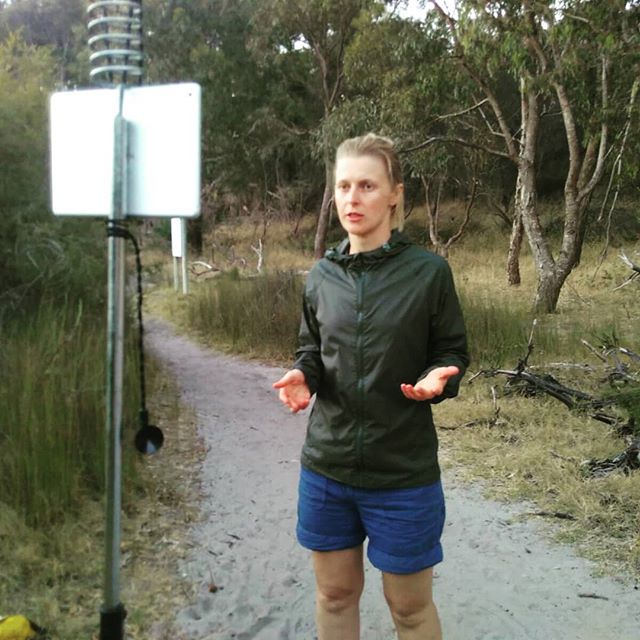
I love that we have been doing it with others #diwo with broader support from our local communities. This PDC is excellent but imperfect, a beautiful whole of diverse parts. Most importantly we are finally launched and live!
Sign up at: https://ift.tt/2EbBoMX
#permaculturewomen
#onlinepermaculture #permacultureinpractice #mooreriverwa #regenerativedesign #riparianzone #permacultureteaching #permacultureeurope #permacultureaustralia via Instagram https://ift.tt/2GPAwDb


